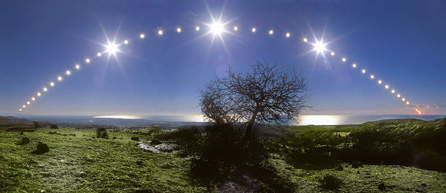Winter officially begins during the third week of each December in North America. This calendar event known as the solstice is marked as the sun briefly “stands still” as its position in the sky reaches the greatest distance from the earth. This celestial alignment is experienced as the shortest day of the year by people in the northern hemisphere as they rush about making holiday preparations. Many cultures celebrate the winter solstice with community gatherings that ritually create more light and warmth during the longest night.
This photograph of the “Tyrrhenian Sea and Solstice Sky” by Danilo Pivato was featured in Astronomy Picture of the Day: “This stiking composite image follows the Sun’s path through the December Solstice day of 2005 in a beautiful blue sky, looking down the Tyrrhenian Sea coast from Santa Severa toward Fiumicino, Italy. The view covers about 115 degrees in 43 separate, well-planned exposures from sunrise to sunset.” Used with permission © Danilo Pivato, 2005, All rights reserved.
The following NSDL resources are designed to shed light on solstice math and science:
From PRISMS: Phenomena & Representations for Instruction of Science in Middle Schools
Earth-Sun Geometry: Winter Solstice Animation
This representation depicts the position of the Earth relative to the Sun during the southern hemisphere’s winter solstice and includes line of latitude and the angle of the Sun’s rays at the Tropic of Capricorn. More information here.
From NSDL Engineering Pathway partner TeachEngineering: Resources for K12
Students will investigate the accuracy of sundials and the discrepancy that lies between “real time” and “clock time”. They will track the position of the sun over the course of a relatively short period of time as they make a shadow plot, a horizontal sundial, and a diptych sundial. More information here.
—
From the NSDL Middle School Portal: A direct path to selective online resources for instruction and professional development from the National Science Digital Library
Understanding why the earth has seasons is one of the most difficult concepts for middle school students to understand. This publication provides resources to help teachers uncover their students misconceptions about the seasons. More information here.
—
From the GLOBE Program:Global Learning and Observations to Benefit the Environment, and DLESE: Digital Library for Earth System Education
Modeling the Reasons for Seasonal Change
The purpose of this resource is to understand what causes the Earth’s seasons with a focus on the Earth’s tilt and spherical shape. Students learn how sunlight spreads over the Earth at different times of the year, emphasizing the solstices and the equinoxes. More information here.
—
From ComPADRE: NSDL Physics and Astronomy Pathway
These web pages provide a short overview of the common (Gregorian) calendar and some less-common ones–Julian, Jewish (leap months), Moslem, Persian (New Year on the spring equinox), Ethiopian and Maya. More information here.



Leave a Comment
* You can follow any responses to this entry through the RSS 2.0 feed.